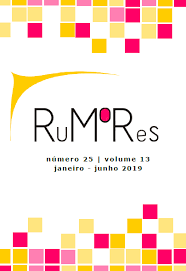Making laugh on TV
narrative fabrication of humor between disparity and disjunction theories
DOI:
https://doi.org/10.11606/issn.1982-677X.rum.2019.146078Keywords:
Humor, isotopy, narrative, sitcom, disparityAbstract
This article proposes an observation of segments from sitcoms to verify how humoristic effect is produced in them – Arrested Development, Friends, Studio 60. In the audiovisual medium, it is also possible to observe that comic situations are conceived under a linear organization, in which two thematic extrapolations collide into incongruence, as predicted by the textual analysis of the jokes proposed by Salvatore Attardo with his isotopy disjunction model. Considering that linearity presupposes rupture and surprise, it becomes possible to approximate the notion of disjunction with that of narrative disparity conceived by Edward Branigan in examining the generation of laughter.
Downloads
References
ALJARED, A. The Isotopy Disjunction Model. In: ATTARDO, Salvatore (org.). The Routledge Handbook of Language and Humor. Nova Iorque: Routledge, 2017.
ATTARDO, S. Linguistic Theories of Humor. Nova Iorque: Mounton de Gruyter, 1994.
BRANIGAN, E. Narrative Comprehension and Film. Nova Iorque: Routledge, 2006.
BRÉMOND, C. “La logique des possibles narratifs”. Communications, n. 8, 1966. Disponível em: < https://bit.ly/2Ja5AMc >. Acesso em: 18 março 2018.
CHATMAN, S. Story and Discourse: narrative strutcture in Fiction and Film. Ithaca: Cornell University Press, 1978.
CHŁOPICKI, W. Humor and Narrative. In: ATTARDO, Salvatore (org.). The Routledge Handbook of Language and Humor. Nova Iorque: Routledge, 2017.
THOMPSON, K. “The Concept of Cinematic Excess”. Ciné-tracts, vol. 1, no. 2, 1977. Disponível em: < http://www.jstor.org/stable/1772358 >. Acesso em: 10 março 2018.
ECO, U. “Two Problems in Textual Interpretation”. Poetics Today, vol. 2, 1a., pp. 145-161, 1980.
_______. Seis passeios pelo bosque da ficção. São Paulo: Companhia das Letras, 2009.
FORABOSCO, G. “Cognitive aspects of the humor process: the concept of incongruity”. Humor, 5-1/2, pp. 45-68, 1992. Disponível em: < https://bit.ly/2IU9Vmr >. Acesso em: 18 fevereiro 2018.
FORSTER, E. M. Aspects of the novel. Orlando: Harcourt, 1955.
GLUSCEVSKIJ, D. “Methodological issues and prospects of semiotics of humour”. Sign System Studies, 45(1/2), pp. 137-15, 2017. Disponível em: < http://bit.ly/2Geff2d >. Acesso em: 25 fevereiro 2018.
HOUAISS, A. Dicionário Eletrônico Houaiss Da Língua Portuguesa [Versão 3.0. CD-ROM]. Rio de Janeiro: Editora Objetiva, 2009.
PROPP, V. I. Morfologia do Conto Maravilhoso. Rio de Janeiro: Forense, 1984.
SULS, J. Cognitive Processes in humor Appreciation. In: McGhee, P. E.; GOLSTEIN, J. H. (orgs.). Handbook of Humor Research. Nova Iorque: Springer –Verlag, 1983.
VOLLI, U. Manual de Semiótica. São Paulo: Edições Loyola, 2007.
Downloads
Published
Issue
Section
License
Declaro a total e irrestrita cessão de direitos autorais sobre o texto enviado para publicação na Rumores – Revista Online de Comunicação, Linguagem e Mídias. Entendo que o conteúdo do artigo é de minha inteira responsabilidade, inclusive cabendo a mim a apresentação de permissão para uso de imagens, ilustrações, tabelas, gráficos de terceiros que, porventura, venham a integrá-lo.









